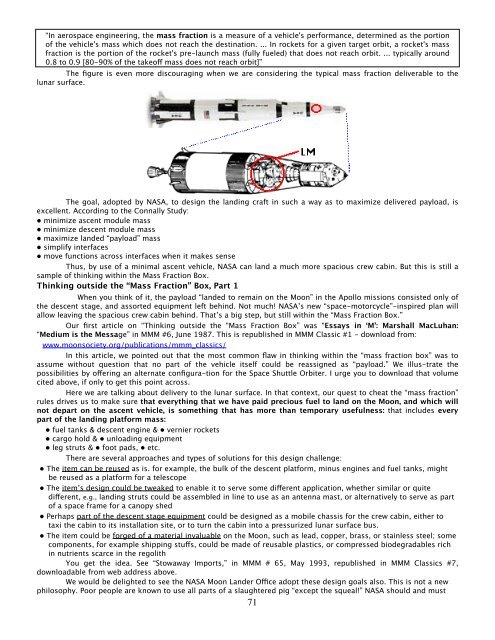Space Transportation - mmmt_transportation.pdf - Moon Society
Space Transportation - mmmt_transportation.pdf - Moon Society
Space Transportation - mmmt_transportation.pdf - Moon Society
Create successful ePaper yourself
Turn your PDF publications into a flip-book with our unique Google optimized e-Paper software.
“In aerospace engineering, the mass fraction is a measure of a vehicle's performance, determined as the portion<br />
of the vehicle's mass which does not reach the destination. ... In rockets for a given target orbit, a rocket's mass<br />
fraction is the portion of the rocket's pre-launch mass (fully fueled) that does not reach orbit. ... typically around<br />
0.8 to 0.9 [80-90% of the takeoff mass does not reach orbit]”<br />
The figure is even more discouraging when we are considering the typical mass fraction deliverable to the<br />
lunar surface.<br />
The goal, adopted by NASA, to design the landing craft in such a way as to maximize delivered payload, is<br />
excellent. According to the Connally Study:<br />
• minimize ascent module mass<br />
• minimize descent module mass<br />
• maximize landed “payload” mass<br />
• simplify interfaces<br />
• move functions across interfaces when it makes sense<br />
Thus, by use of a minimal ascent vehicle, NASA can land a much more spacious crew cabin. But this is still a<br />
sample of thinking within the Mass Fraction Box.<br />
Thinking outside the “Mass Fraction” Box, Part 1<br />
When you think of it, the payload “landed to remain on the <strong>Moon</strong>” in the Apollo missions consisted only of<br />
the descent stage, and assorted equipment left behind. Not much! NASA’s new “space-motorcycle”-inspired plan will<br />
allow leaving the spacious crew cabin behind. That’s a big step, but still within the “Mass Fraction Box.”<br />
Our first article on “Thinking outside the “Mass Fraction Box” was “Essays in ‘M’: Marshall MacLuhan:<br />
“Medium is the Message” in MMM #6, June 1987. This is republished in MMM Classic #1 - download from:<br />
www.moonsociety.org/publications/mmm_classics/<br />
In this article, we pointed out that the most common flaw in thinking within the “mass fraction box” was to<br />
assume without question that no part of the vehicle itself could be reassigned as “payload.” We illus-trate the<br />
possibilities by offering an alternate configura-tion for the <strong>Space</strong> Shuttle Orbiter. I urge you to download that volume<br />
cited above, if only to get this point across.<br />
Here we are talking about delivery to the lunar surface. In that context, our quest to cheat the “mass fraction”<br />
rules drives us to make sure that everything that we have paid precious fuel to land on the <strong>Moon</strong>, and which will<br />
not depart on the ascent vehicle, is something that has more than temporary usefulness: that includes every<br />
part of the landing platform mass:<br />
• fuel tanks & descent engine & • vernier rockets<br />
• cargo hold & • unloading equipment<br />
• leg struts & • foot pads, • etc.<br />
There are several approaches and types of solutions for this design challenge:<br />
• The item can be reused as is. for example, the bulk of the descent platform, minus engines and fuel tanks, might<br />
be reused as a platform for a telescope<br />
• The item’s design could be tweaked to enable it to serve some different application, whether similar or quite<br />
different, e.g., landing struts could be assembled in line to use as an antenna mast, or alternatively to serve as part<br />
of a space frame for a canopy shed<br />
• Perhaps part of the descent stage equipment could be designed as a mobile chassis for the crew cabin, either to<br />
taxi the cabin to its installation site, or to turn the cabin into a pressurized lunar surface bus.<br />
• The item could be forged of a material invaluable on the <strong>Moon</strong>, such as lead, copper, brass, or stainless steel; some<br />
components, for example shipping stuffs, could be made of reusable plastics, or compressed biodegradables rich<br />
in nutrients scarce in the regolith<br />
You get the idea. See “Stowaway Imports,” in MMM # 65, May 1993, republished in MMM Classics #7,<br />
downloadable from web address above.<br />
We would be delighted to see the NASA <strong>Moon</strong> Lander Office adopt these design goals also. This is not a new<br />
philosophy. Poor people are known to use all parts of a slaughtered pig “except the squeal!” NASA should and must<br />
71















